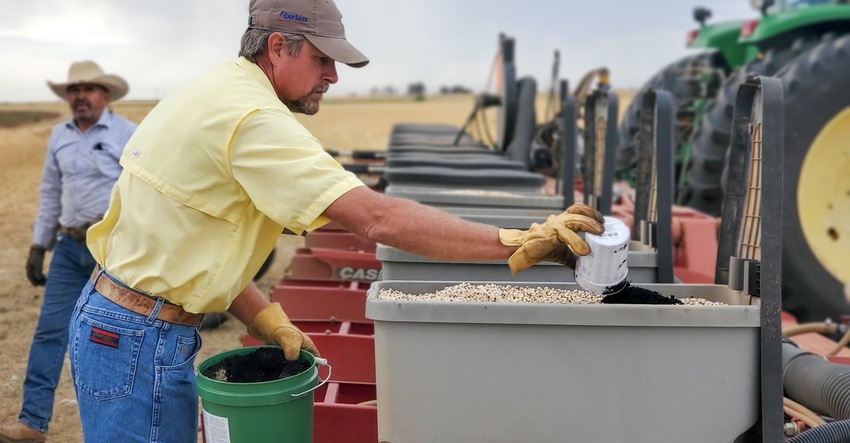
It's a good year for beans.
"It's rare as a farmer that you're in a seller's market," says Bobby Redwine, general manager, Texas Best Bean & Seed, Olton, Texas. "Usually, the sellers tell a producer what they'll pay." But this year, it's the farmers telling the buyers what they want for their crop, he says.
 (Bobby Redwine, general manager, Texas Best Bean & Seed, Olton, Texas.)
(Bobby Redwine, general manager, Texas Best Bean & Seed, Olton, Texas.)
A short supply of dry beans from the 2019 crop, coupled with a renewed interest in home cooking heightened by grocery angst during the COVID-19 quarantine, has created that seller's market.
In 2019, whether it was black-eyed peas, crowders, limas, or pinto beans, nationwide the dry bean market suffered weather-related losses. "It didn't matter where you were growing a dry bean last year, Mother Nature didn't help," Redwine says. "Here in August, too many 109-degree days made our peas light instead of solid and heavy. Then some of them got rained out prior to harvest."
California's yields were light as well, and in the Dakotas, Redwine says flooding reduced pinto bean yields. "Flooding kept them out of the field. When they finally got them planted, that area got an early freeze, so it made for a shortage of edible beans."
Next came COVID-19. "The pandemic caused people to start hoarding stuff from the grocery store, and that further exasperated the problem," Redwine says.
See, Relationships prove to be key in black-eyed pea market
This year, Redwine, who's been contracting with growers since 2001, says his black-eyed pea contracts are up 15%. He contracts with producers as far north as Stratford and as far south as Brownfield. "I've got more than I've ever had," he says. "Two years ago, we had significant carryovers in a lot of different varieties, crowders, black-eyes, and pintos. But this year, we're facing a completely different situation."
Hale County Black-eyes
In Hale County, producers Shane and Shelley Berry and Shelley's father, Joe McFerrin, contract 300 acres of black-eyed peas with Redwine. Traditionally, the trio grows cotton, corn and wheat. A depressed cotton market and little rainfall intertwined with limited irrigation capacity motivated them to try something new.
When Farm Press caught up with the Berrys, they were loading the planter with black-eyed peas and a residual herbicide, BroadAxe. As the tractor entered the field, Cleto Longoria, who's worked for the family since the late 1980s, slowly let the planter down and began to plant 60 acres initially set aside for corn.
"The corn didn't look promising this year," Shane says. "We had corn booked up until I put the first cotton seed in the planter. We talked with Joe and decided to call the dealer and send it all back. There are some wrecks on corn."
Since January, the Berry's farm has only received 4.5 inches of rainfall.
"On this farm, we have 1,250 gallons of water per minute," Shelley says. "We don't farm the whole circle. It's a 480-acre pivot, but we'll only have 370 acres planted. There's not enough water to go around."
"And if we don't get any help from rain, there's no way to keep up," Shane adds. "On the quarter at the house, I may have to shorten acres because I'd rather grow good cotton on 80 acres than burn up 120 acres. We're just going to have to shorten it if we don't get any help.
"On this circle with 310 acres of cotton and 60 of black-eyes, we're probably pushing it this year."
As Longoria planted, Shane followed, periodically dropping to one knee, pushing the soil back with his finger to check seed depth, while across the turnrow, a sprayer applied herbicide on their cotton acres.
Field Trials
Prior to planting, the Berrys apply compost on all of their acres. "The ground seems like it takes moisture better. We picked up a farm two years ago that hadn't had any compost applied and you go around with the pivot and the water would just run in front of it. It wouldn't soak down. With the humus in the soil, it just works better," Shane says.
They soil test to determine nutrient needs. Test results have begun to reveal deficient calcium levels.
"We have two places that are basically identical, very close in proximity and water, and you can tell that one place has continued to decrease in yield compared to the other," Shelley says. "We've been soil testing and began to say, 'Something's going on.' The only thing that popped up was our calcium levels."
What's to blame? "It's caused by the irrigation water, salty water.”
To determine the best method to increase calcium levels, the Berrys and McFerrin are conducting field trials with their crop consultant Randy Redinger, Ag Producers Co-op, Olton.
 (Randy Redinger, Ag Producers Co-op, Olton.)
(Randy Redinger, Ag Producers Co-op, Olton.)

"There's a point in time on black-eyed peas when tissue sampling shows calcium deficiency," Redinger says. "So, right in the middle of that 60 acres of peas, I put out calcium, CalSul. The outside part of the piece doesn't have calcium on it. We came back over the top of the whole area with a liquid fertilizer blend."
On another field of black-eyes, Redinger applied the CalSul but with dry fertilizer. "My thoughts are that by the time the calcium deficiency starts to show up in the tissue samples, I'd rather have it in the soil where the plant can take it up earlier. It's definitely a trial, but consistently, when I pull tissue samples on black-eyed peas, about the time they go into full bloom, they're deficient in calcium."
Black-eyes bloom, set pods, eventually mature, and then crash. To lengthen the maturity, Redinger applied copper with the calcium. "It seems like it extends that time about another 10 days before they crash. They'll inevitably crash, but if we can extend it, it's more fruiting time.
"It goes hand-in-hand when black-eyes crash the calcium and copper levels are low."
Rotation
Black-eyes are a legume, so they require less nitrogen, Shane says. "They make their own," which Shelley says will be beneficial for the 2021 cotton crop. "It should help us carry forward to the next year. The cotton should start the season better off."
This fall, the Berrys will dust off their all-crop header to harvest the peas. "We've had it 15 years. We'll just have to make sure it turns because we haven't used it in 12 to 14 years," Shane says with a laugh.
The Berrys admit they have a lot to learn about producing peas, but hope their new venture will generate a profit in a year clouded by unknowns.
Read more about:
Black eyed PeasAbout the Author(s)
You May Also Like






